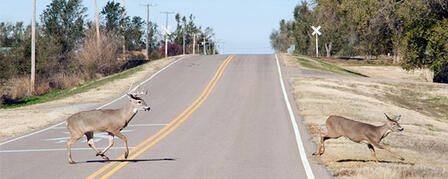KANSAS DEER-VEHICLE COLLISIONS PEAK DURING NOVEMBER

Oct. 17, 2013
In 2012, nearly 8,700 vehicle accidents in Kansas involved deer
TOPEKA – Deer can be spotted near our state’s roadways any time of the year. However, in the fall, motorists should be especially vigilant for deer crossing the highways. Deer breeding season peaks in mid-November, and this marks the period when deer-vehicle collisions are highest. That’s why the Kansas Department of Transportation (KDOT), the Kansas Department of Wildlife, Parks and Tourism (KDWPT), and the Kansas Highway Patrol are working together to raise awareness and help drivers avoid collisions with deer.
According to KDWPT biologist Lloyd Fox, the increase in deer-vehicle crashes is strongly influenced by the deer mating season, called “rut.” During rut, deer focus on mating; they travel more than in other seasons and pay less attention to hazards such as vehicles. Also during the fall, many deer move to more secure areas as crops are harvested and leaves fall from trees and shrubs.
Not only are deer more active during the fall, but shorter days mean dusk and dawn — when deer are more likely to be on the move — occur when commuter traffic is highest. According to KDOT spokesperson Steve Swartz, 15 percent, or 8,695, of all traffic crashes in 2012 involved deer. Two people were killed and 322 were injured in these crashes. Deer-vehicle collisions occur in every Kansas county. In most cases, counties with high human populations and high traffic volumes record the most deer-vehicle crashes. Johnson County recorded the most crashes with 304, followed by Sedgwick County with 293, and Reno County with 237. The good news is the number of deer-related accidents has continued to decline since 2004 when 9,954 accidents were recorded.
Motorists should observe the following tips to avoid deer collisions:
- Be especially watchful at dawn and dusk when deer are particularly active;
- Watch for more than one deer, as they seldom travel alone;
- Reduce speed and be alert near wooded areas or green spaces such as parks or golf courses and near water sources such as streams or ponds;
- Don’t swerve to avoid hitting a deer – the most serious accidents sometimes occur when motorists swerve and collide with another vehicle or run off the road and hit an obstacle;
- Heed deer crossing signs;
- Always wear a seat belt and use appropriate child safety seats; and
- Use bright lights and slow down whenever the reflective eyes of deer are spotted.
According to KHP Lieutenant Joshua Kellerman, if you hit a deer, slow down and pull onto the shoulder, turn on your emergency flashers, and watch for traffic if you have to exit your vehicle. If you have a cellular phone and are on a Kansas highway, dial *47 (*HP) for a highway patrol dispatcher, *582 (*KTA) for assistance on the Kansas Turnpike, or dial 911.
Anyone involved in a vehicle-deer crash resulting in personal injury or property damage that totals $1,000 or more is required to immediately report the crash to the nearest law enforcement agency. Failure to report any traffic crash is a misdemeanor and may result in suspension of driving privileges.
A salvage tag is required to remove a deer carcass from an accident site. Tags can be issued by KHP troopers, sheriff’s deputies, or KDWPT natural resource officers.
If you are involved in a non-injury crash on an interstate, U.S. highway, or any divided or multi-lane road in the state of Kansas, and if you are not transporting hazardous materials, you are required by law to move your vehicle out of the lane of traffic. This law is intended to help keep drivers and passengers safe by getting them out of the lane of traffic and away from oncoming vehicles.
-30-









